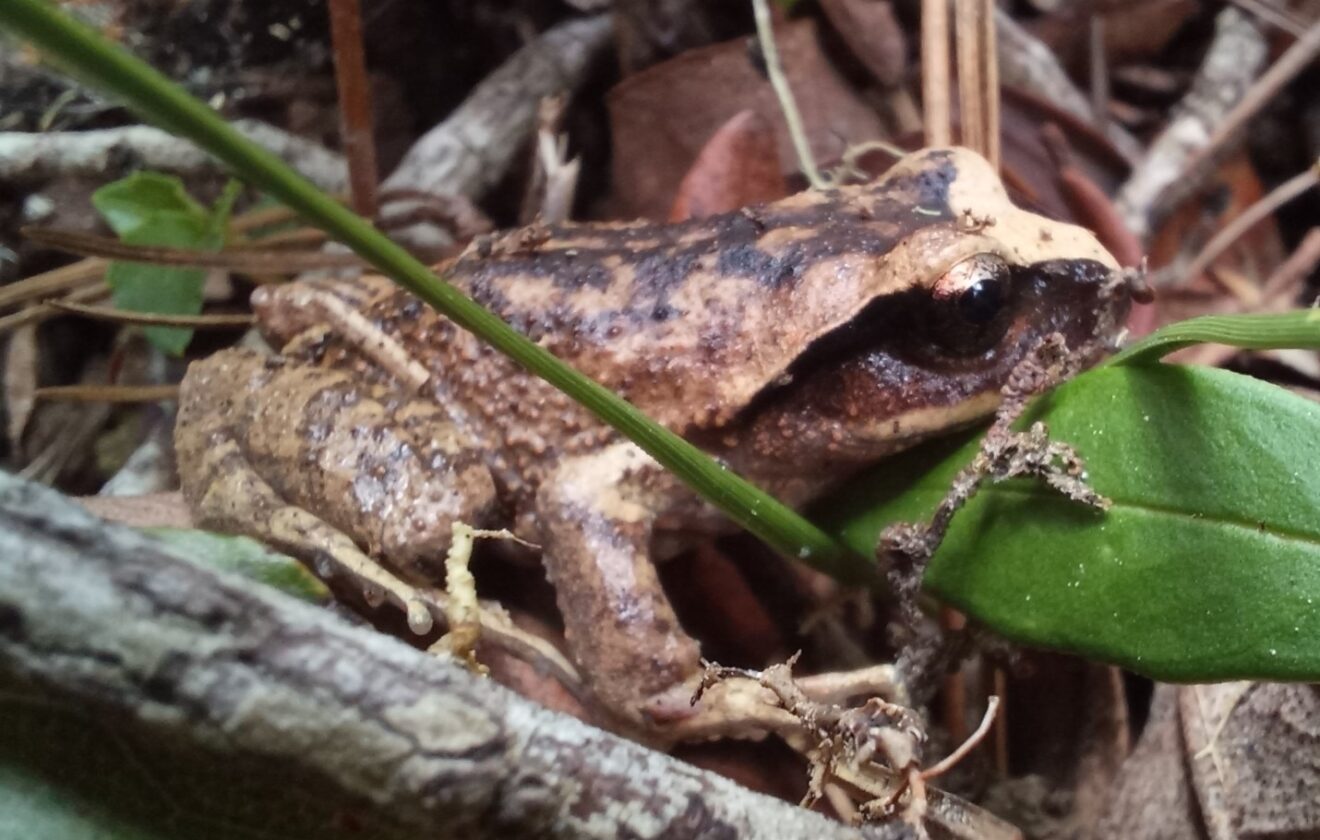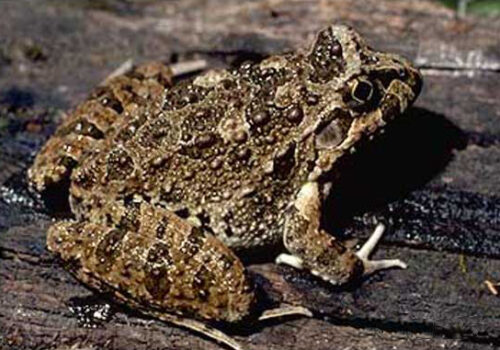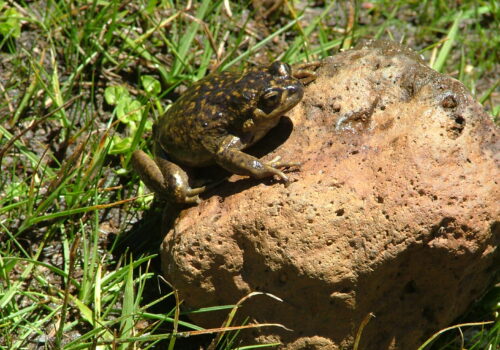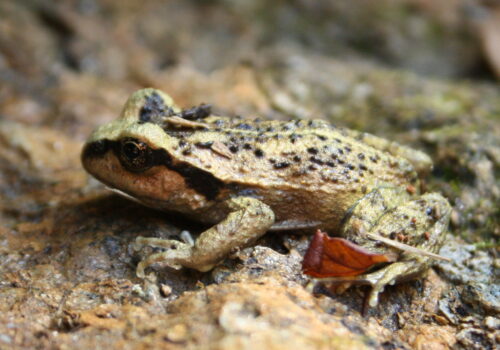- Discovering Alsodes vanzolinii: The Secretive Frog of the Andean Streams
- Taxonomy and Classification: Unveiling Identity Through Science
- Natural Habitat: Life Amidst Cool Andean Waters
- Physical Characteristics: Camouflage and Adaptation in Subtle Colors
- Behavior and Life Cycle: Invisible Narratives in Quiet Streams
- Ecological Role: Guardians of Andean Stream Ecosystems
- Threats and Conservation Status: Persevering on the Edge
- Cultural and Scientific Significance: Appreciation Beyond Ecology
- Conclusion: Protecting Alsodes vanzolinii—Preserving Nature's Balance
Discovering Alsodes vanzolinii: The Secretive Frog of the Andean Streams#
In the shadow-dappled forests of southern Chile, where crystalline mountain streams wind gently through moss-carpeted valleys, exists a small amphibian so discreet in presence yet so noteworthy for science and conservation alike—the elusive Alsodes vanzolinii. Commonly overshadowed by charismatic terrestrial mammals or vividly colored tropical frogs, Alsodes vanzolinii, through quiet existence, reveals an enchanting narrative that deserves our attention, advocacy, and admiration.
Named in honor of the renowned Brazilian herpetologist Paulo Emilio Vanzolini, this species epitomizes the delicate balance between amphibian life and its habitat—the temperate forests and freshwater streams crucial to sustaining their intricate life histories. Let’s explore together this hidden treasure of the amphibian world, unearthing its secrets within a narrative alive with wonder, science, and the sincere desire for conservation.
Taxonomy and Classification: Unveiling Identity Through Science#
Alsodes vanzolinii belongs to Alsodidae, a specialized family of frogs primarily associated with cool temperate habitats of South America, especially Chile and Argentina. Within this family, the genus Alsodes comprises several cryptic, reclusive amphibians adapted to life along mountain streams and moist forest environments. Emerging from the careful scrutiny and analytical precision of taxonomists, Alsodes vanzolinii was formally described in 1975, illuminating a previously hidden piece of South America’s intricate amphibian tapestry.
Although many species within the genus Alsodes appear outwardly similar, detailed morphological studies, bioacoustics, and genetic analyses have affirmed Alsodes vanzolinii’s distinct identity. Its classification underscores the importance of rigorous biodiversity surveys to avoid overlooking cryptic yet ecologically critical species.
Natural Habitat: Life Amidst Cool Andean Waters#
The haunting melody of flowing waters and rustling leaves resonates through the habitat of Alsodes vanzolinii, nestled within a narrow geographical range of south-central Chile’s temperate Andean forests. Regions such as Valdivia and nearby locales, renowned for lush ecosystems and high rainfall, provide a perfect backdrop for these inconspicuous amphibians to flourish.
Forests and Streams: A Symphony of Coexistence#
Alsodes vanzolinii preferentially inhabits densely forested riparian corridors, where permanent mountain brooks carve gently through terrain blanketed in moss, liverwort, and rich understory vegetation. These pristine watercourses not only shape the landscape but also define the species’ entire life history. An amphibian’s dependence upon freshwater bodies for various life stages—egg laying, tadpole growth, and adult survival—is a central tenet in ecological storylines, exemplified beautifully by Alsodes vanzolinii’s life cycle.
Characterized by cool climates, high humidity, and shaded conditions, these forests offer consistent moisture—an absolute necessity for such sensitive creatures. The frog’s close association with narrow streams and rocky substrates underscores its specialized habitat requirement. The frog’s persistence provides valuable bioindicators of environmental integrity, revealing underlying ecological balance or reflecting habitat disturbances.
Physical Characteristics: Camouflage and Adaptation in Subtle Colors#
Alsodes vanzolinii might initially appear modest, a frog intended by evolution to remain hidden. Adults measure roughly between 35 to 50 millimeters in snout-vent length, making them neither exceptionally large nor particularly striking at first glance. Yet, careful observation reveals evolutionary perfection in their subtle appearance.
Their coloration ranges thoughtfully within shades of earthy olive browns or grayish greens, peppered occasionally with subtle markings and variations that mimic damp soil and leaf litter impeccably. Robust hind limbs and relatively webbed digits equip Alsodes vanzolinii especially well for navigating swift mountain currents and slippery, moss-covered surfaces—perfect adaptations mirroring their microhabitat.
Smooth yet moist skin serves a dual purpose—remarkably efficient water retention in terrestrial environments and respiration aids underwater. Meanwhile, their large, expressive eyes grant nocturnal advantages—alerting them to movement of potential predators or unsuspecting insect prey under dim moonlight.
Behavior and Life Cycle: Invisible Narratives in Quiet Streams#
Life among forest streams necessitates subtlety. Alsodes vanzolinii, predominantly crepuscular and nocturnal, emerges under cover of darkness to hunt, mate, or explore territories silently. Typically sedentary, individuals occupy small home ranges along streambanks and forest floors, where they patiently await prey or visage suitable mates.
Feeding Strategies: Ambush by Night#
Alsodes vanzolinii possesses a simple yet effective predation method. Relying upon ambush tactics, these amphibians patiently watch from concealed points such as patches of moss or crevices in rocks, neatly camouflaged and near-indistinguishable from their surroundings. Upon the unsuspecting approach of insects, spiders, or other small invertebrates, rapid extensions of sticky tongues swiftly subdue prey—highlighting evolutionary precision in simplicity.
The Delicate Dance of Reproduction#
Breeding takes place primarily during warm, humid periods, usually correlating with heavy rains. Males vocalize subtly from streamside perches, their calls—soft, repetitive, and mellow—barely rising above the gentle murmur of running waters. Bringing males and females together anew each season ensures genetic vibrancy and enhances population resilience.
Females deposit eggs in delicate clusters, attached securely to underwater substrates—be they cold stones, submerged branches, or roots of waterside vegetation. Tadpoles, fully adapted to the oxygen-rich currents of mountain streams, have morphological specializations granting proper respiration in fast-flowing waters. Over several months, they transform gradually, emerging eventually as tiny frogs ready to inhabit terrestrial habitats adjacent to streams, thus continuing an ancient lifecycle close to the waters’ eternal flow.
Ecological Role: Guardians of Andean Stream Ecosystems#
Despite their size and secretive existence, Alsodes vanzolinii occupy an indispensable ecological niche. Serving simultaneously as predator and prey, these frogs exercise significant control over aquatic insect populations, subtly regulating stream ecosystems, nutrient cycling, and food-web stability.
Their vulnerability in turn supports predators such as birds, snakes, and small mammals, underscoring their integral and interconnected role in a thriving, balanced ecosystem. Furthermore, sensitive to slight disturbances, the frogs act as reliable “biosensors,” indicating health or deterioration within forest-stream habitats and guiding conservationists tackling wider environmental issues.
Threats and Conservation Status: Persevering on the Edge#
While detailed assessments are limited, Alsodes vanzolinii—like many enigmatic amphibians within temperate ecosystems—is currently categorized as Data Deficient by the International Union for Conservation of Nature (IUCN). Regardless, habitat fragmentation, deforestation, water extraction projects, climate fluctuations, invasive species, and infectious fungal diseases like chytridiomycosis pose real threats to their ongoing existence.
The conservation plight faced by amphibians worldwide—a steep decline in numbers and diversity—is mirrored remarkably in Alsodes vanzolinii, highlighting the urgent need for detailed studies and habitat protections to safeguard this silent ambassador of Andean forests.
Cultural and Scientific Significance: Appreciation Beyond Ecology#
Named in tribute to esteemed Brazilian zoologist Paulo Vanzolini, Alsodes vanzolinii bridges scientific discovery and respect for nature’s intricate yet vulnerable diversity. Further research may unveil biochemical compounds, insights into physiology adapted to oxygen-rich waters, or ecological resilience indicators contributing broader biological and ecological understandings beyond amphibian studies alone.
Although culturally less visible than charismatic megafauna, Alsodes vanzolinii embodies Andean ecosystems’ hidden wonders, reminding humanity of the unseen biodiversity enriching our planet—a narrative no less deserving of awe, respect, and stewardship.
Conclusion: Protecting Alsodes vanzolinii—Preserving Nature’s Balance#
Peering through the veil of mossy forests and mountain brooks, we have glimpsed the unassuming yet profound life narrative of Alsodes vanzolinii. Safeguarding their quiet realms requires not only scientific curiosity but active choices valuing intact ecosystems, freshwater integrity, and habitat protection.
Let the subtle voice of Alsodes vanzolinii remind us that every organism—visible or hidden—holds intrinsic ecological worth. Here’s your invitation to dive deeper, to connect with amphibian conservation efforts, and ensure these humble frogs continue softly serenading the Andean forests for generations still unseen and unheard, but no less deserving of sustained existence.











